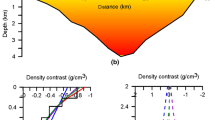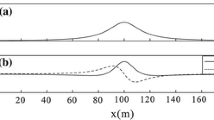Abstract
The depth from extreme points (DEXP) method can be used for estimating source depths and providing a rough image as a starting model for inversion. However, the application of the DEXP method is limited by the lack of prior information regarding the structural index. Herein, we describe an automatic DEXP method derived from Euler’s Homogeneity equation, and we call it the Euler–DEXP method. We prove that its scaling field is independent of structural indices, and the scaling exponent is a constant for any potential field or its derivative. Therefore, we can simultaneously estimate source depths with different geometries in one DEXP image. The implementation of the Euler–DEXP method is fully automatic. The structural index can be subsequently determined by utilizing the estimated depth. This method has been tested using synthetic cases with single and multiple sources. All estimated solutions are in accordance with theoretical source parameters. We demonstrate the practicability of the Euler–DEXP method with the gravity field data of the Hastings Salt Dome. The results ultimately represent a better understanding of the geometry and depth of the salt dome.
Similar content being viewed by others
References
Abbas, M.A., and Fedi, M., 2014, Automatic DEXP imaging of potential fields independent of the structural index: Geophysical Journal International, 199(3), 1625–1632.
Abbas, M.A., Fedi, M., and Florio, G., 2014, Improving the local wavenumber method by automatic DEXP transformation: Journal of Applied Geophysics, 111, 250–255.
Debeglia, N., and Corpel, J., 1997, Automatic 3–D interpretation of potential field data using analytic signal derivatives: Geophysics, 62(1), 87–96.
Fedi, M., 2007, DEXP: A fast method to determine the depth and the structural index of potential fields sources: Geophysics, 72(1), I1–I11.
Fedi, M., and Abbas, M.A., 2013, A fast interpretation of self–potential data using the depth from extreme points method: Geophysics, 78(2), E107–E116.
Hsu, S. K., 2002, Imaging magnetic sources using Euler’s equation: Geophysical Prospecting, 50(1), 15–25.
Huang, D., Gubbins, D. A., Clark, R. A., and Whaler, K., 1995, Combined Study of Euler’s Homogeneity Equation for Gravity and Magnetic Field: 57th EAGE Conference and Technical Exhibition, Glasgow, Scotland, cp-90-00372. https://doi.org/10.3997/2214-4609.201409565
Keating, P., and Pilkington, M., 2004, Euler deconvolution of the analytic signal and its application to magnetic interpretation: Geophysical Prospecting, 52(3), 165–182.
Li, X., 2006, Understanding 3D analytic signal amplitude: Geophysics, 71(2), L13–L16.
Liu, S., Baniamerian, J., and Fedi, M., 2020, Imaging Methods Versus Inverse Methods: An Option or An Alternative?: IEEE Transaction on Geosci. Remote Sensing, 58(5), 3484–3494.
Ma, G., Yong, X., Li, L., and Guo, H., 2020, Three–dimensional gravitational and magnetic data acquisition and analysis via a joint–gradient Euler deconvolution method: Applied Geophysics, 17(02), 297–305.
Maiolino, M., and Fedi, M., 2022, Excess mass from DEXP transformation of the gravity field: 83rd EAGE Annual Conference and Technical Exhibition, Madrid, Spain, 1–5. https://doi.org/10.3997/2214-4609.202210819
Mauriello, P., and Patella, D., 2001, Gravity probability tomography: a new tool for buried mass distribution imaging: Geophysical Prospecting, 49(1), 1–12.
Nabighian, M. N., 1972, Analytic signal of two-dimensional magnetic bodies with polygonal cross-section: its properties and use for automated anomaly interpretation: Geophysics, 37(3), 507–517.
Okocha, F.C., 2017. Gravitational Study of the Hastings Salt Dome and Associated Faults in Brazoria and Galveston Counties, Texas: Master’s Thesis, Austin State University, US.
Reid, A.B., Allsop, J.M., Granser, H., Millett, A.J., and Somerton, I.W., 1990, Magnetic interpretation in three dimensions using Euler deconvolution: Geophysics, 55(1), 80–91.
Reid, A.B., and Thurston, J.B., 2014, Structural index in gravity and magnetic interpretation: Errors, uses, and abuses: Geophysics, 79(4), J61–J66.
Roest, W.R., Verhoef, J., and Pilkington, M., 1992. Magnetic interpretation using the 3–D analytic signal: Geophysics, 57(1), 116–125.
Stavrev, P., and Reid, A., 2007. Degrees of homogeneity of potential fields and structural indices of Euler deconvolution: Geophysics, 72(1), L1–L12.
Stavrev, P.Y., 1997. Euler deconvolution using differential similarity transformations of gravity or magnetic anomalies: Geophysical Prospecting, 45(2), 207–246.
Thompson, D.T., 1982, EULDPH: A new technique for making computer-assisted depth estimates from magnetic data: Geophysics, 47(1), 31–37.
Thurston, J. B., and Smith, R. S., 1997. Automatic conversion of magnetic data to depth, dip, and susceptibility contrast using the SPI (TM) method: Geophysics, 62(3), 807–813.
Zhou, W., and Liu, C., 2018, Depth from extreme points method for gravity gradient tensor data: Geophysical Prospecting, 66(2), 432–443.
Acknowledgments
We would like to thank Okocha, F.C. for sharing the gravity field data of the Hastings Salt Co. We greatly appreciate two anonymous reviewers for their constructive comments and the editorial department of APPLIED GEOPHYSICS for their support. This research was supported by the National Natural Science Foundation of China (Grant No. 42176186).
Author information
Authors and Affiliations
Corresponding author
Additional information
This research is supported by the National Natural Science Foundation of China (Grant No. 42176186).
Zhao Guo-xing: assistant engineer, graduated from Jilin University in 2014 with a bachelor’s degree in Applied Geophysics. He received a master’s degree in Geodetection and Information Technology from Jilin University in 2017. He is currently working at the First Institute of Oceanography, Ministry of Natural Resources in Qingdao. His research interests include the processing and interpretation of potential field data.
Wu Yong-ting: professor of engineering, graduated from Wuhan Technical University of Surveying and Mapping in 1994 with a bachelor’s degree in Geodesy. He received a doctoral degree in Geodesy and Survey Engineering from Wuhan University in 2013. He is currently working at the First Institute of Oceanography, Ministry of Natural Resources in Qingdao. His research interests include marine geodetic surveys and deep ocean marine survey technology.
Rights and permissions
About this article
Cite this article
Zhao, Gx., Wu, Yt., Sun, Y. et al. Automatic DEXP method derived from Euler’s Homogeneity equation. Appl. Geophys. 19, 572–579 (2022). https://doi.org/10.1007/s11770-022-0953-3
Received:
Revised:
Published:
Issue Date:
DOI: https://doi.org/10.1007/s11770-022-0953-3




